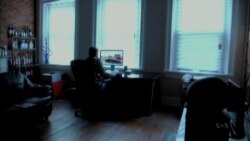A young American takes to the road with his video camera, in a motorcycle journey around the Arab world, and ends up fighting alongside Libyan rebels. It may sound like fiction, but it’s a true story, and the subject of a new documentary, “Point and Shoot,” by director Marshall Curry.
Much of the film was shot by its subject and co-producer, Matthew VanDyke. In his mid-20s, VanDyke had earned an advanced degree in security studies, with a concentration in Middle Eastern affairs. But he was still living at home in Maryland with his mother, who still did his laundry and cooked his meals. In a bid to jumpstart his life, he bought a motorcycle and drove it more than 5,600 kilometers through the Arab world, filming himself along the way. It was a kind of journey of “self-discovery,” he said in an interview, a self-initiation into manhood. He planned to make an adventure-travel movie.
For someone afflicted with obsessive-compulsive disorder, and used to washing his hands dozens of times a day, the trip was full of small terrors. His fear of dirt and bugs was constantly tested. When he encountered a squat toilet-hole, he didn’t know what it was, and used the shower instead. Eating from a communal bowl with Libyan friends was another challenge. His motorcycle got stuck in sand and broke down. He was arrested and detained in several countries. In Kabul, a street mob roughed him up. In Iraq, American soldiers taught him how to shoot automatic weapons - his first experience with a gun.
But the friends he made, particularly a Libyan named Nouri, were the best he had ever known, he said. So when the Arab Spring broke out, and the Libyan revolution began, he packed up and left his perplexed girlfriend and mother behind in Baltimore again.
“When the revolution started, I was in contact with those friends over the Internet and by phone, and they told me what was happening, and I realized that this was a place I cared about and people I cared about, and I couldn’t just sit at home and do nothing,” VanDyke said. “It was partly ideological and partly to help my friends.”
Soon after he met up with Nouri and other rebels, he was taken prisoner by dictator Moammar Gadhafi’s forces.
“I was on a reconnaissance mission in a town called Brega, and I suffered an injury, lost consciousness, and woke up in prison to the sound of a man being tortured in the cell above me,” VanDyke said. He was taken to Tripoli and spent nearly six months in one of Gadhafi’s worst prisons.
“I had no books, nothing to read, nothing to do, basically paced back and forth in my cell, not knowing if I would be tortured, trimming my fingernails and toenails down so they couldn’t rip them out during torture, and wondering if I would be killed or executed, or spend the rest of my life in prison,” he said.
An eerie animation sequence in the film depicts his auditory hallucinations and delusions there.
“It’s a common effect of solitary confinement, the mind’s way of protecting itself. I was going through sensory deprivation, so my mind compensated by creating auditory hallucinations that I was being traded and would be released,” VanDyke said. But when he was freed, in a mass prison break, he did not even consider returning home to recuperate.
“Of course I was going to go back to the frontline; nothing had really changed,” he said. “When I came to Libya I told the men I was with [that] I would stay until Libya was free. And my mother raised me to honor my commitments, so I was going to stay -- I wasn’t going to leave until we achieved victory.”
Carrying a gun in one hand, and often his camera in the other, he continued to film his experiences and those of the other fighters, who also used their cell phones to upload images to their Facebook pages. It was the first war to be documented in real time by combatants.
With the revolution won, VanDyke returned to the United States, and sought out Academy Award-nominated documentarian Marshall Curry to make “Point and Shoot.” It was no longer a simple adventure-travel film and, VanDyke felt, “I needed to create a bit of distance, for people to take it seriously and credibly,” he said. And he was busy making another film, a short called “Not Anymore”, about Syria’s revolution, that he wanted to use to raise funds and awareness of the fight there. Both films have won numerous awards, including the top documentary prize for “Point and Shoot” at the 2014 Tribeca Film Festival.
VanDyke has put aside filmmaking for now, and dedicated himself instead to activism for groups fighting Syrian president Bashar al-Assad and the Islamic State, or ISIS.
“I am taking everything I learned over the years on the road and in all the countries, in Libya especially, and finding new and creative ways to apply it mostly in the fight against ISIS now,” he said, declining to describe exactly how.
“Part of me wants to go straight to Kobani right now and help defend it. I wanted to go to Syria and join the men on the front line right after Libya, but I looked at the situation. They didn’t have enough weapons and ammunition, not enough international support, and I’m not Rambo. I would be just another man on the frontline with a weapon, and the contribution I could make would not be as significant,” as what he could do from the sidelines as an activist and strategist, he added.
But his travels to the region are not over. As “Point and Shoot” opens in theaters in the U.S., VanDyke is planning a trip to Iraq in December, partly to deliver $15,000 he raised for humanitarian aid for Kurds there.






